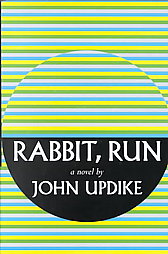
Apologies for opening with a technical observation, but mid-way through John Updike's Rabbit, Run, he violates his established point-of-view. We have been with Rabbit Angstrom up to this point in the novel, closely following his movements and thought, until on 122 we zip into his girlfriend Ruth's head with the sentence "These eyes sting her and she turns her head away to hide the tears, thinking, That's one of the signs, crying easily." And then four pages later, after Rabbit has told Ruth that "If you have the guts to be yourself...other people'll pay your price," one turns the page and reads:
Making awkward calls is agony for Eccles; at least anticipation of them is. Usually, the dream is worse than the reality: so God has disposed the world. The actual presences of people are always bearable. Mrs. Springer is a plump, dark, small-boned woman with a gypsy look about her. Both the mother and the daughter have a sinister aura, but in the mother this ability to create uneasiness is a settled gift, throughly meshed into the strategies of middle-class life. With the daughter it is a floating thing, useless and as dangerous to herself as to others. Eccles is relieved that Janice is out of the house; he feels guiltiest in her presence. She and Mrs. Fosnacht have gone into Brewer to a matinee of Some Like It Hot. Their two sons are in the Springers' back yard. Mrs. Springer takes him through the house to the screened-in porch, where she can keep an eye on the children.By that point it's clear that not only are we not in Rabbit's head, he's not even here. What started as a momentary zip across the room four pages earlier has now leapt away from our point-of-view character altogether.
And nicely done.
To readers who don't write fiction, the observation above might seem fussy, but when picking up Rabbit, Run in the wake of Updike's recent death, this reader was happily reminded of how loose, fresh, and confident Updike was with language, and how generous he was toward himself as a writer. When technical considerations or the following of standard point-of-view "rules" might prevent him from exploring certain aspects of his characters, Updike smoothly lets himself off the hook in order to explore the material he wants to explore and to keep the novel zipping forward.
Now, yes, they aren't rules, they're only guidelines. And yet a fiction isn't a fiction without dramatic tension, and one of the quickest ways to bore a reader is too let them know to much. The unknowns of the future, for instance, intrigue humans, while an omniscient god who knows the entirety of human history past and future has nothing to wonder about or look forward to. That god doesn't quite have "time" in the sense of that word meaning anything, in fact, and, even as a god, would only be able to write a novel in the usual way: leave some unknowns so that the reader wants to turn the page. Though there is something we call "omniscient point of view," that doesn't actually exist. And no one wants it.
This is all to say that, as has been pointed out by many readers over the last fifty years, Updike is a master of language--and yet one of the pleasures of reading an early novel like Rabbit, Run is that one sees him fine tuning the way in which he handles the technical challenges of crafting a novel in order to maximize his opportunities to explore (and, yes, occasionally to flex or preen) that linguistic facility. The scene above, in which Jack Eccles visits Rabbit's mother-in-law, goes on to include the following:
She leads him slowly; both of her ankles are bound in elastic bandages. The pained littleness of her steps reinforces his illusion that her lower body is encased in a plaster cast. She gently lets herself sink onto the cushions of the porch glider and startles Eccles by kicking up her legs as with a squeak and sharp sway the glider takes her weight. The action seems to express childish pleasure; her bald pale calves stick out stiff and her saddle shoes are for a moment lifted from the floor. These shoes are cracked and rounded, as if they've been revolved in a damp tub for yearsIt's silly to act as if writing is a competition, and yet: many of us would have made do with the workmanlike "Stiffly, she sat down." And if we workshopped it, we would probably be informed that we need to cut the scene, anyway, because we haven't stayed with our POV character. So the place Updike has gotten to at this point in the novel is a place we would never get to. And his handling of the moment is better than ours would have been, anyway.
There is a rather shocking attention to and stacking up of images in Rabbit, Run. There is verb play, body-ogling, stream-of-consciousness, and the linguistic fingering, hefting, and holding of many objects in the novel's world. We don't watch the characters in Rabbit, Run; we swim along beside them.
Though this is the first Rabbit novel, it isn't one of the Rabbit pieces that won a big prize. And yet this reader zipped happily through the 255 skillful pages here. And, yes, occasionally made a note in the margin: "POV?" The question mark, perhaps, will be erased.
No comments:
Post a Comment